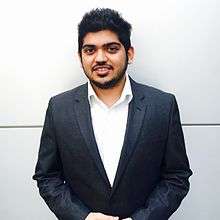Karan Jani
Karan Jani (born May 18, 1988) is an Indian astrophysicist working on black holes, gravitational waves, and testing Albert Einstein's General Theory of Relativity.[1][2][3] He is part of the LIGO team which led to the first observation of gravitational waves from binary black hole merger. He also published a paper in Nature journey recently highlighting a new approach for observing an elusive class of black holes called Intermediate black holes[4][5][6][7] He has also worked at the prestigious LIGO Livingston Observatory in the US and the Albert Einstein Institute in Germany, besides the Georgia Institute of Technology and the Perimeter Institute for Theoretical Physics in Canada, where physicist Stephen Hawking was a research director.[8][9][7]
Karan Jani | |
|---|---|
 | |
| Born | 18-05-1988 |
| Nationality | Indian |
| Known for | Black holes, Gravitational Waves |
| Home town | Vadodra, Gujarat |
| Website | http://www.karanjani.com/ |
He is a member of the Indian Initiative in Gravitational-wave Observations effort to build gravitational wave detector LIGO in India.[10][11]
Early life and education
Karan was born in Mumbai, India and did his K-12 schooling in Baroda, Gujarat. He attended Maharaja Sayajirao University before joining Penn State from where he obtained his degrees in physics, astronomy, astrophysics along with a minor in mathematics. He is currently a graduate student at the Georgia Institute of Technology. He has previously held undergraduate research positions at the Institute of Gravitation and Cosmos at Penn State, Max Planck Institute for Gravitational Physics and Perimeter Institute for Theoretical Physics.
He was part of the delegation that met with the Prime Minister of India Narendra Modi in Washington DC for the historic signing of MoU between National Science Foundation and Department of Atomic Energy to build a LIGO detector in India.[12] The LIGO-India project is ranked as the top science-technology priority in the India–United States relations.[13]
In his past interviews, Karan has stated Albert Einstein, Stephan Hawking and Subrahmanyan Chandrasekhar as his inspiration.[14]
Awards and recognition
- Forbes 30 Under 30 recipient in Science - 2017[15][16][17]
- Jani was a co-recipient of the Special Breakthrough Prize in Fundamental Physics for that work - 2016[3][8]
- GRAVITY fellow at Vanderbilt.[18]
- Cover page of Issue 3 of Nature Astronomy on Gravitational Wave is credited to Karan Jani.[19]
- Finalist of Vanderbilt Prize for undergraduate research in Physics and Astronomy - 2009 [20]
References
- Feb 13, TNN | Updated; 2016; Ist, 09:09. "Vadodara man behind simulation of Einstein's gravitational waves | Vadodara News - Times of India". The Times of India. Retrieved 2020-03-17.CS1 maint: numeric names: authors list (link)
- Vadukut, Sidin (2016-03-27). "Of LIGO, gravitational waves and a revolution in physics". Livemint. Retrieved 2020-03-17.
- Gough, Evan (2020-02-05). "14% of all the Massive Stars in the Universe are Destined to Collide as Black Holes". Universe Today. Retrieved 2020-03-17.
- Jani, Karan; Shoemaker, Deirdre; Cutler, Curt (March 2020). "Detectability of intermediate-mass black holes in multiband gravitational wave astronomy". Nature Astronomy. 4 (3): 260–265. arXiv:1908.04985. doi:10.1038/s41550-019-0932-7. ISSN 2397-3366.
- Jani, Karan; Shoemaker, Deirdre; Cutler, Curt (2020). "Detectability of Intermediate-Mass Black Holes in Multiband Gravitational Wave Astronomy". Nature Astronomy. 4 (3): 260–265. arXiv:1908.04985. Bibcode:2019NatAs.tmp..488J. doi:10.1038/s41550-019-0932-7.
- LIGO Scientific Collaboration and Virgo Collaboration; Abbott, B. P.; Abbott, R.; Abbott, T. D.; Acernese, F.; Ackley, K.; Adams, C.; Adams, T.; Addesso, P.; Adhikari, R. X.; Adya, V. B. (2017-07-11). "Search for intermediate mass black hole binaries in the first observing run of Advanced LIGO". Physical Review D. 96 (2): 022001. arXiv:1704.04628. Bibcode:2017PhRvD..96b2001A. doi:10.1103/PhysRevD.96.022001.
- "Observing 'black hole symphony' using gravitational wave astronomy". www.nsf.gov. Retrieved 2020-03-17.
- Thomas, Maria. "An Indian's journey from A Brief History of Time to meeting Stephen Hawking". Quartz India. Retrieved 2020-03-17.
- Mar 15, Tushar Tere | TNN | Updated; 2018; Ist, 09:16. "stephen hawking.: Karan Jani recalls lunch with Hawking | Vadodara News - Times of India". The Times of India. Retrieved 2020-03-17.CS1 maint: numeric names: authors list (link)
- Jul 26, TNN |; 2016; Ist, 07:03. "LIGO India project to take off soon | Vadodara News - Times of India". The Times of India. Retrieved 2020-03-17.CS1 maint: numeric names: authors list (link)
- "Astrophysicist, LIGO researcher Karan Jani proposes space research center at MSU". The Indian Express. 2016-10-20. Retrieved 2020-03-17.
- "Georgia Tech PhD Student Called To Meet India's Prime Minister". www.news.gatech.edu. Retrieved 2020-03-17.
- George, Varghese K. (2016-04-01). "LIGO project: 2 Indian scientists in US excited about possibility of returning home". The Hindu. ISSN 0971-751X. Retrieved 2020-03-17.
- "Interview With Dr. Karan Jani". CosmosNow. 2020-01-12. Retrieved 2020-03-18.
- "30 Under 30 2017: Science". Forbes. Retrieved 2020-03-17.
- automaton (2017-01-03). "Karan Jani named in Forbes 30 Under 30 in Science". School of Physics. Retrieved 2020-03-17.
- Staff, ByVadim SupitskiyForbes. "Karan Jani". Forbes. Retrieved 2020-03-17.
- Turney, Spencer. "Here's how a Vanderbilt astrophysicist plans to observe a black hole 'symphony' using gravitational wave astronomy". Vanderbilt University. Retrieved 2020-03-17.
- "Volume 4 Issue 3, March 2020". www.nature.com. Retrieved 2020-03-17.
- "Center for Gravitational Wave Physics - News". cgwp.gravity.psu.edu. Retrieved 2020-03-17.